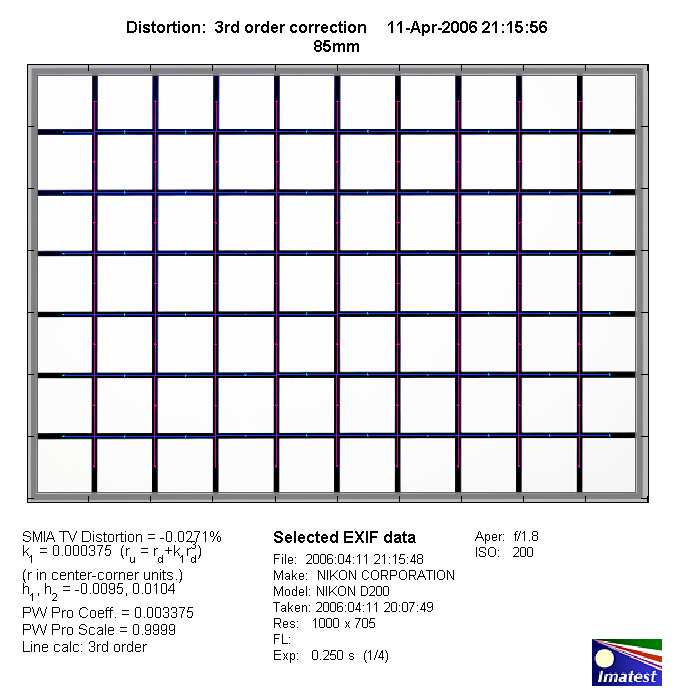|
Page 2 of 2

Distortion
On DX cameras the lens is free of distortion.

The chart above has a real-world size of about 120x80cm.
Vignetting
Being a FX lens, the Nikkor profits from the sweet spot advantage on DX cameras and consequently shows only minor vignetting wide open, which is reduced to an irrelevant level at f/2.8 and beyond.

MTF (resolution)
The image center shows very good resolution wide open already. Stopped down to f/2.8 and beyond, the resolution is excellent at all tested aperture settings.
The borders and corners follow a bit behind with just good sharpness wide open. However, stopped down to f/2.8 the sharpness already reaches very good values here and even excellent resolution at f/5.6 and f/8.
Please note that the MTF results are not directly comparable across the different systems!
Below is a simplified summary of the formal findings. The chart shows line widths per picture height (LW/PH) which can be taken as a measure for sharpness.
If you want to know more about the MTF50 figures you may check out the corresponding Imatest Explanations

Chromatic Aberrations (CAs)
Chromatic aberrations (color shadows at harsh contrast transitions) are very low and exceptionally well controlled.

Bokeh
One of the primary usage scenarios for a large aperture lens is to seperate the main subject from the background. In such an image the quality of the bokeh (out-of-focus blur) is of major significance.
The image blur in front of the focal plane is very smooth, however that's not something you'll often benefit from in real world shots. Behind the focal plane the bokeh quality is a bit lower, with slightly nervous blur.
Background highlights show some outlining wide open that can be reduced by stopping down. At large apertures the highlights have a circular shape (except towards the image borders, where they are slightly cut off due to mechanical vignetting), but stopped down the shape of the aperture begins to form polygons instead.

Bokeh Fringing
Bokeh fringing is a common issue with relatively fast glass. It's visible as halos of different colors in out-of-focus areas - magenta (red + blue) in front of the focus point
and green beyond.
Typical for most fast primes the AF-D 85 shows noticeable bokeh fringing at large aperture settings, which can of course be reduced by stopping down.
Sample Images
You can find some sample images taken with the Nikon D3x in our Nikon FX review of the lens.
VerdictThe Nikkor AF 85mm f/1.8 D performs on a very high level. Sharpness is very good wide open and excellent across the frame stopped down.
Typical for a fast prime there is some visible vignetting as well as bokeh fringing wide open, both of which can be reduced by stopping down. CAs and distortion are very well controlled.
The build quality is on a high level. Not quite up to pro standards, but certainly nothing to worry about for the average shutterbug. If anything, it looks a bit outdated compared to newer AF-S lenses.
So, does it perform better than its faster and more expensive cousins? Well, not quite, there is one property where it falls short: bokeh. The quality of the background blur is not bad, but lower than with most ultra fast portrait primes. If you're after buttery smooth bokeh, this is not your primary choice. For anyone else, though, the lens offers tremendous value for a quite affordable price.
|